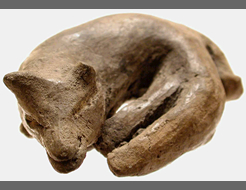|
||||||||||||||||||||||||||||||||
|
|
Museum of: Bucharest | |||||||||||||||||||||||||||||||
| Name of the artefact: The Fox of Pietrele | ||||||||||||||||||||||||||||||||
|
The figurine, made of polished, grey clay, is one of
the most realistic zoomorphic statuettes discovered in Romania |
||||||||||||||||||||||||||||||||
|
WHERE IS IT AND MAIN
CHARACTERISTICS |
STATE |
|||||||||||||||||||||||||||||||
|
Department: |
Archaeology |
Preservation: |
Very good | |||||||||||||||||||||||||||||
|
Inventory number: |
13724 |
Restauration: |
Restored | |||||||||||||||||||||||||||||
|
Name of the artefact: |
The Fox of Pietrele |
Completeness: |
Complete | |||||||||||||||||||||||||||||
|
Object type: |
Animal figurine |
|||||||||||||||||||||||||||||||
|
Material: |
Clay |
|||||||||||||||||||||||||||||||
|
Methof of manufacture: |
Shaping |
|||||||||||||||||||||||||||||||
|
Decoration
type: |
No decoration |
|||||||||||||||||||||||||||||||
|
Distinctive mark: |
- |
|||||||||||||||||||||||||||||||
|
DIMENSIONS |
PERIOD OF USE |
|||||||||||||||||||||||||||||||
|
Length (mm): |
53 |
Epoque: |
Neolithic |
|||||||||||||||||||||||||||||
|
Heigth
(mm): |
- |
Culture: |
Gumelniţa |
|||||||||||||||||||||||||||||
|
Diameter
(mm): |
- |
Period: |
Eneolithic |
|||||||||||||||||||||||||||||
|
Width (mm): |
38 |
Face: |
A2 |
|||||||||||||||||||||||||||||
|
Thickness (mm): |
- |
Absolute chronology: |
4500-4000 BC |
|||||||||||||||||||||||||||||
|
Weight
(g): |
- |
|||||||||||||||||||||||||||||||
DISCOVERY |
||||||||||||||||||||||||||||||||
|
Date: |
1948 |
Country: |
Romania |
|||||||||||||||||||||||||||||
|
District: |
Giurgiu |
Town hall affiliation: |
Băneasa |
|||||||||||||||||||||||||||||
|
Village: |
Pietrele |
Discovery findspot: |
Gorganu |
|||||||||||||||||||||||||||||
|
Condition of discovery: |
Archaeological excavation |
Discovery type: |
Dwelling |
|||||||||||||||||||||||||||||
|
ANALYSES – DETERMINATIONS |
FILLED IN BY |
|||||||||||||||||||||||||||||||
|
Type: |
- |
Name: |
Radian Andreescu, Katia
Moldoveanu |
|||||||||||||||||||||||||||||
|
Laboratory: |
- |
Institution: |
Romanian National History
Museum |
|||||||||||||||||||||||||||||
|
No./Code: |
- |
Date: |
07/12/2005 |
|||||||||||||||||||||||||||||
|
DEEPENINGS |
||||||||||||||||||||||||||||||||
|
Morphology of the object: |
||||||||||||||||||||||||||||||||
|
The head of the figurine has pointed ears and the eyes
marked by horizontal incisions. The long snout has the mouth marked by an
incision. The body is bending. The tightly front legs lay down under the
body and the back legs reaching toward head. This position suggests that
the animal, probably a fox, is slipping or resting. |
||||||||||||||||||||||||||||||||
|
Decoration: |
||||||||||||||||||||||||||||||||
|
- |
||||||||||||||||||||||||||||||||
|
Inscription: |
||||||||||||||||||||||||||||||||
|
- |
||||||||||||||||||||||||||||||||
|
Analogies: |
||||||||||||||||||||||||||||||||
|
The zoomorphic figurines are relatively numerous in the
sites belonging to Gumelniţa civilization. Most of them are very schematic
modelled, sometimes even roughly and they often represent bovines. Wild
animals as deer, fox, and turtle can be found rarer. Few figurines
representing heads of pig, deer and fox are modelled in a realistic manner
with focusing on the anatomic details. Zoomorphic vessels are a special
category, some of them being realistic modelled and having a sophisticate
decoration. |
||||||||||||||||||||||||||||||||
|
Interpretation: |
||||||||||||||||||||||||||||||||
|
The obvious attitude of resting of this animal could be
linked with some magical rituals of hunt. The animal could also have a
special meaning for the human community, being a kind of totem. |
||||||||||||||||||||||||||||||||
|
Bibliography: |
||||||||||||||||||||||||||||||||
|
Author: Dumitrescu, Vl Title: Arta preistorică în
România Place: Bucureşti Year: 1974 2. Author: Berciu, D Title: Cercetări
arheologice în regiunea Bucureşti Periodical: Materiale şi cercetări
arheologice Volume: II Place:Bucureşti Year: 1956 3. Author: Gimbutas,
Marija Title: The Gods and Goddesses of Old Europe Place: London Year:
1974 |
||||||||||||||||||||||||||||||||

